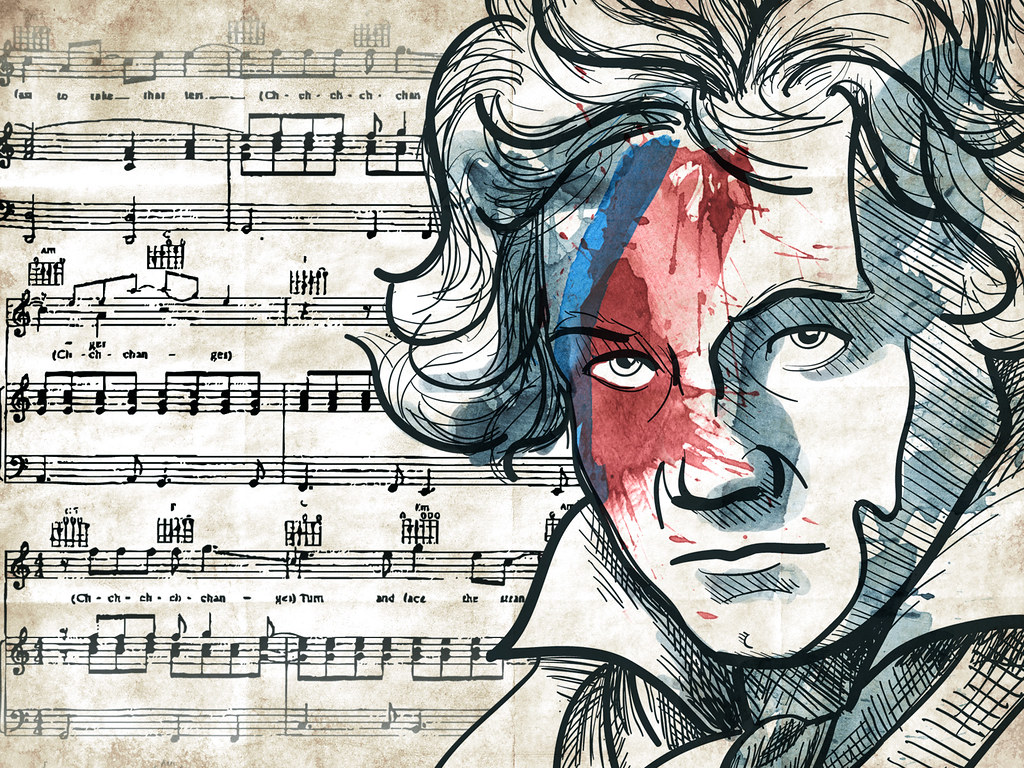Ludwig van Beethoven, one of the most influential composers in Western music, bridged the Classical and Romantic eras with his innovative compositions. His works are celebrated for their emotional depth, structural complexity, and inventive use of musical forms. Here are ten of Beethoven’s most renowned compositions:
1. Symphony No. 9 in D Minor, Op. 125 (“Choral”)
Description:
Beethoven’s Ninth Symphony is perhaps his most monumental work, famous for its final movement featuring Friedrich Schiller’s “Ode to Joy.” This symphony revolutionized the genre by including vocal soloists and a choir, transforming the traditional symphonic form.
Highlights:
- Fourth Movement: The “Ode to Joy” theme represents universal brotherhood and has become a symbol of hope and unity worldwide.
- Innovative Structure: Combines elements of traditional symphonies with choral and vocal sections, paving the way for future symphonic compositions.
Legacy:
The Ninth Symphony has been used in numerous significant cultural and political contexts, including the fall of the Berlin Wall and the European Union’s anthem.
2. Symphony No. 5 in C Minor, Op. 67
Description:
The Fifth Symphony is arguably Beethoven’s most famous composition, renowned for its four-note “fate” motif. The symphony’s progression from struggle to triumph mirrors Beethoven’s personal battles with deafness and adversity.
Highlights:
- Opening Motif: The four-note motif (short-short-short-long) is one of the most recognizable phrases in classical music.
- Emotional Journey: Moves from the dramatic tension of the opening movement to a triumphant and victorious finale.
Legacy:
The Fifth Symphony is a staple in concert repertoires and has influenced countless composers and musicians.
3. Symphony No. 3 in E-Flat Major, Op. 55 (“Eroica”)
Description:
Originally dedicated to Napoleon Bonaparte, the “Eroica” Symphony marked a turning point in Beethoven’s career and in the symphonic form, characterized by its heroic scale and emotional depth.
Highlights:
- First Movement: Notable for its bold and complex development, breaking classical conventions.
- Funeral March: The second movement is a somber and reflective tribute, contrasting with the heroic theme.
Legacy:
“Eroica” is considered a precursor to the Romantic symphony, emphasizing individual expression and expanded musical forms.
4. Piano Sonata No. 14 in C-Sharp Minor, Op. 27, No. 2 (“Moonlight Sonata”)
Description:
The “Moonlight Sonata” is one of Beethoven’s most beloved piano works, characterized by its ethereal first movement and dramatic contrasts.
Highlights:
- First Movement: A serene and contemplative adagio, often likened to moonlight shining on a tranquil lake.
- Final Movement: A tempestuous presto agitato, showcasing Beethoven’s mastery of the piano.
Legacy:
This sonata remains a favorite among pianists and listeners alike, known for its emotional intensity and technical demands.
5. Piano Sonata No. 8 in C Minor, Op. 13 (“Pathétique”)
Description:
The “Pathétique” Sonata is renowned for its expressive power and dramatic contrasts, reflecting Beethoven’s early Romantic style.
Highlights:
- Grave – Allegro di molto e con brio: The first movement’s somber opening and fiery allegro set the tone for the sonata’s passionate nature.
- Adagio Cantabile: The second movement is one of Beethoven’s most lyrical and beloved pieces.
Legacy:
“Pathétique” remains a cornerstone of piano literature, admired for its emotional depth and virtuosity.
6. Violin Concerto in D Major, Op. 61
Description:
Beethoven’s only violin concerto stands out for its lyrical beauty and technical demands, elevating the genre to new artistic heights.
Highlights:
- First Movement: A noble and expansive allegro, with a majestic solo entrance.
- Cadenza: The violin cadenza showcases the soloist’s virtuosity and Beethoven’s ingenuity.
Legacy:
The Violin Concerto is a staple of the violin repertoire, celebrated for its balance between the soloist and orchestra.
7. Missa Solemnis in D Major, Op. 123
Description:
The “Missa Solemnis” is one of Beethoven’s greatest choral works, reflecting his deep spirituality and innovative approach to sacred music.
Highlights:
- Gloria: A jubilant and powerful movement, expressing praise and exultation.
- Agnus Dei: A profound and introspective conclusion, blending traditional liturgical elements with Beethoven’s personal voice.
Legacy:
Though not as frequently performed as some of his other works, the “Missa Solemnis” is considered a masterwork of choral music.
8. Piano Concerto No. 5 in E-Flat Major, Op. 73 (“Emperor”)
Description:
The “Emperor” Concerto is Beethoven’s final and most grandiose piano concerto, characterized by its heroic spirit and innovative dialogue between the soloist and orchestra.
Highlights:
- First Movement: Begins with a powerful orchestral introduction followed by a virtuosic piano entry.
- Second Movement: A serene and lyrical adagio, contrasting with the energetic final rondo.
Legacy:
The “Emperor” Concerto is a favorite in the concerto repertoire, admired for its brilliance and emotional range.
9. String Quartet No. 14 in C-Sharp Minor, Op. 131
Description:
This late string quartet is celebrated for its intricate structure and profound emotional depth, consisting of seven continuous movements.
Highlights:
- Fugue: The quartet opens with a complex and introspective fugue, showcasing Beethoven’s mastery of counterpoint.
- Varied Movements: Each movement transitions seamlessly, creating a cohesive and compelling narrative.
Legacy:
The Op. 131 quartet is revered by both musicians and scholars, considered one of Beethoven’s most significant contributions to the genre.
10. Symphony No. 6 in F Major, Op. 68 (“Pastoral”)
Description:
The “Pastoral” Symphony is a programmatic work depicting scenes from nature, reflecting Beethoven’s love for the countryside.
Highlights:
- “Awakening of Cheerful Feelings upon Arrival in the Country”: The first movement captures the joy of arriving in the countryside.
- “Storm”: The fourth movement vividly depicts a thunderstorm, a remarkable example of Beethoven’s descriptive power.
Legacy:
The “Pastoral” Symphony has inspired countless nature-themed compositions and remains a beloved work for its vivid imagery and serene beauty.
Conclusion
Ludwig van Beethoven’s compositions have left an indelible mark on the world of music, blending technical mastery with profound emotional expression. From the heroic triumph of the “Eroica” Symphony to the serene beauty of the “Moonlight Sonata,” his works continue to resonate with audiences and musicians around the globe, embodying the spirit of innovation and the power of music to transcend time and place.


Comments are closed